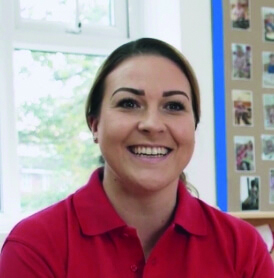
Excitement or happiness can quickly turn to frustration and upset as young children grapple with their emotions. Learning how to recognise and communicate this wide range of feelings is an important part of growing up. Practitioners can help by providing a safe place, the language and resources to support children to explore and consider their emotions.
The best resource of all, says early years consultant Penny Tassoni, is a caring adult who is tuned in to the child. ‘You have to be very realistic about what any resource will deliver because it is always humans who deliver on emotions,’ she explains.
She adds, ‘They may be playing with cuddly animals, setting goals, modelling social situations and using props, but it is adults who help children to make sense of situations through conversations.’
SHARING BOOKS
‘Books give the opportunity to vicariously explore issues,’ says Anne Harding, an independent trainer specialising in children’s books and reading. ‘The very fact of sharing books in a peaceful, calm, supportive and cosy atmosphere leads to children feeling safer to discuss emotions or anxieties.’
She says it is important to have a book collection that ‘embodies diversity and inclusion’ so children can see their own circumstances reflected in books. Along with having books that can prepare children for new experiences, such as going to the dentist, she suggests having story books that display a range of emotions – positive as well as negative ones, with many popular story books doing this well, from fear and hopefulness to boredom and joy. For example, what does it feel like to be the mouse in The Gruffalo?
‘Abstract concepts can be made more real through storylines and characters,’ says Ms Tassoni. ‘Books give children an indirect way of learning the language of emotion. Children can be quick to pick up on extremes of emotions such as anger or sadness but can need help with the more subtle ones, such as disappointment – that “oh” feeling when you don’t get what you want. Happy/sad flash cards are simplistic and not subtle enough, whereas experiencing a scenario through a book can help children understand.’
Anne Harding recommends dialogic reading (see Further information) to enable children to explore books at a deeper level. ‘Sharing a book is not about getting through the words and shutting the book,’ she says. ‘Practitioners need to give children time to reflect and only then can they raise questions or concerns or make links with their situation.’
Rather than assuming children have the language to reply, practitioners should scaffold language and make comments such as ‘He must be feeling sad’ or ‘I bet he was disappointed’.
Props to accompany books can also be helpful. Children can then return to and re-enact scenarios or change the ending. ‘This gives children a sense of agency and allows them to feel in control,’ says Ms Harding.
Small-world play and role play
‘Acting can help children to express how they are feeling, whether through small-world play or role play,’ says Ms Tassoni. ‘It helps them to play out different scenarios and learn about social interactions. They can learn about different roles, such as experiencing being the baby and having things done for them or being a parent and being in charge.’
She emphasises that it is very important for all settings to have a home corner, rather than changing it into something different. ‘A home corner enables children to explore their emotions and feelings by acting out socio-domestic play, playing out what they have seen and heard at home and taking it to different levels. It needs to be reflective of children’s own circumstances so they can connect to it.’
Ms Tassoni recommends observing what children are exploring through their play and using it as a basis to further explore their ideas and expand their vocabulary. ‘If you see a child being unkind to another in the context of drama, it could be that they are experiencing this and you could use it as an opportunity to share a related book,’ she says.
Puppets
Puppets can also be used to act out positive and negative behaviour and offer a pressure-free space to engage children who may otherwise be reticent to speak to an adult. Aim for a range of puppets that represent different cultures and ethnicity.
Construction
‘When building things, it may not always go as the child wants, but that’s all part of the learning,’ says Ms Tassoni. ‘Children need to experience natural setbacks and be supported through them with comments such as “I wonder why that happened?” or “What do you need to do differently?”. There is a sense of achievement when completing something, which can lead to a positive sense of self.’
She suggests praising perseverance, such as congratulating a child when it took them three times to achieve what they wanted, or asking them how it made them feel rather than just focusing on the completion.
Whereas some children get angry or give up easily, others may have high levels of resilience and perseverance. ‘It’s all about knowing your children and knowing where the “safety net” needs to go,’ she adds.
Developing a language of positivity around attempts to do something gives children an important tool for later life.
Real-life experiences
Children can achieve a sense of competence, help to care for others and gain confidence through being involved in real-life experiences such as watering plants, sweeping up or being involved in cooking activities which involve patience and deferred gratification – having to wait for the food to cook and cool before eating it. To encourage children to persevere, they need child-sized tools that are designed for them and work properly.
Jeni Sutton, senior manager, Kids Inc Nurseries
 ‘We used to be more rigid around our exploration of emotions and expressing feelings with resources such as emotion picture cards, but we have learnt that not all of children’s emotions can fit into these. Children don’t just feel happy, sad or angry but a wide range of emotions,’ says Jeni Sutton.
‘We used to be more rigid around our exploration of emotions and expressing feelings with resources such as emotion picture cards, but we have learnt that not all of children’s emotions can fit into these. Children don’t just feel happy, sad or angry but a wide range of emotions,’ says Jeni Sutton.
‘One child said she felt “wiggly” so we talked to her about that and gave her a range of words to express that; she was happy but fidgety and wanted to go outside. We use books and play to support children to articulate their feelings and reassure them that it is OK to have strong emotions, such as to feel cross – but it is not OK to hit someone.
‘It’s down to practitioners to know their children and tune in to how they are feeling. We make sure our nurseries have cosy spaces where children can sit and be quiet and just think, or have a chat with a key person. Mealtimes are also good times to express emotions, likes and dislikes, and we find that boys especially open up when we go for a walk and a talk.
‘We use story books to encourage children to have an opinion or discuss how a particular character may be feeling. This not only enables children to verbalise emotions but builds confidence. Knowing that their opinions matter helps children feel valued.
‘Small-world play and role play are great tools for enabling children to open up or play through their thoughts and feelings, especially children with SEND who may need more visual cues – small world dinosaurs can roar and show rage or run away frightened. One boy was playing doctors and nurses and pretended to have a cough because he had coronavirus. He was exploring how it may feel, thinking about it and acting it out, which can be reassuring and a way of taking control. Through this type of play, children also learn how to include others in their games, listen, collaborate and resolve conflicts.
‘We try to have a wide range of resources, including open-ended ones, and allow children to experiment and take risks. Construction is important as it’s not all about the finished product. Children need to concentrate, persist and keep their emotions under control. Once they have achieved, they often display great pride and satisfaction.’
BOOKS
- Ruby’s Worry by Tom Percival (Bloomsbury Children’s Books)
- What Makes Me Happy by Catherine and Laurence Anholt (Walker Books)
- Time to Make Friends/Time to Share by Penny Tassoni and Mel Four (Featherstone)
- Letterbox Library specialises in books reflecting equality and diversity, www.letterboxlibrary.com
FURTHER INFORMATION
- http://www.anneharding.net
- ‘Dialogic reading – Let’s share’, Nursery World, April 2019: www.nurseryworld.co.uk/features/article/dialogic-reading-let-s-share
RESOURCES
- Range of book and character sets from Early Excellence, www.earlyexcellence.com
- Family Puppets by Wesco, www.wesco-eshop.co.uk
- Early Years Resources Dolls, www.earlyyearsresources,co.uk
- ProCook Children’s Baking Set, www.procook.co.uk
- Dolls House Families by TTS, www.tts-group co.uk









